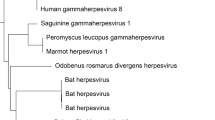Summary
The ability of several strains and recombinants of herpes simplex virus 1 (HSV-1) to proliferate in the adrenal glands and to invade the spinal cord was studied. After intraperitoneal infection, pathogenic HSV-1 strains replicated in the adrenal glands, penetrated the spinal cord and migrated to the brain. The nonpathogenic strain HFEM could not replicate in the adrenal glands, but the recombinant virus MLC1 was able to do so after rescue by reinsertion of theHpaI-P sequence into theBamHI fragment of HFEM DNA. However the recombinant MLC1 virus could not penetrate the spinal cord.
The effect of HSV-1 infection on the expression of the cellular genes for multidrug resistance (in the adrenal glands) and proenkephalin A (in the spinal cord) was also studied.
Similar content being viewed by others
References
Baharani M, Boxerbaum B, Gilger AP, Rosenthal MS, Zrie TM (1966) Generalized herpes simplex and hypoadrenocorticisim. A case associated with adrenocortinal insufficiency in prematurely born male: clinical, virological, opthalmological, and metabolic studies. Am J Dis Child 3: 437–445
Becker Y, Hadar J, Tabor E, Ben-Hur T, Raibstein I, Rosen A, Darai G (1986) A sequence inHpaI-P fragment of herpes simplex virus-1 DNA determines intraperitoneal virulence in mice. Virology 149: 256–259
Ben-Hur T, Asher Y, Tabor E, Darai G, Becker Y (1987) HSV-1 virulence for mice by the intracerebral route is encoded by theBamHI-L DNA fragment containing the cell fusion gene. Arch Virol 96: 117–122
Ben-Hur T, Hadar H, Shtram Y, Gilden DH, Becker Y (1983) Neurovirulence of herpes simplex type 1 depends on age in mice and thymidine kinase expression. Arch Virol 78: 303–308
Ben-Hur T, Rosen A, Lamade W, Darai G, Becker Y (1988) HSV-1 DNA sequence determining intraperitoneal pathogenicity in mice is required for transcription of viral immediate-early genes in macrophages. Virology 163: 397–404
Chirgwin JM, Przybyla AE, MacDonald RJ, Rutter WJ (1979) Isolation of biologically active ribonucleic acid from sources enriched in ribonucleases. Biochemistry 18: 5294–5299
Douglass J, Civelli O, Herbert E (1984) Polyprotein gene expression, generation of diversity of neuroendocrine peptides. Annu Rev Biochem 53: 665–715
Fojo AT, Ueda K, Salmon DJ, Poplack DG, Gottesman MM, Pastan I (1987) Expression of a multidrug resistance gene in human tumors and tissues. Proc Natl Acad Sci USA 84: 265–269
Frenkel JK (1960) Pathogenesis of infection of the adrenal gland leading to Addison's disease in man: role of corticoids in adrenal and generalized infection. Ann NY Acad Sci 84: 393–440
Goodpasture EW, Teague O (1923) Experimental production of herpetic lesions in organs and tissues of the rabbit. J Med Res 44: 121–139
Gordon Y, Gilden DH, Shtram Y, Asher Y, Tabor E, Wellish M, Devlin M, Snipper D, Hadar J, Becker Y (1983) A low thymidine-kinase-producing mutant of herpes simplex virus type 1 causes latent trigeminal ganglia infections in mice. Arch Virol 76: 39–49
Gros P, Ben-Neriah Y, Croop JM, Hausman DE (1986) Isolation and expression of a complementary DNA that confers multidrug resistance. Nature 323: 728–731
Haynes RE, Azina PH (1963) Fatal herpes hominis (herpes simplex virus) infection in children. JAMA 206: 312–320
Hill TJ, Yirrel DL, Blyth W (1986) Infection of the adrenal gland as a route to the central nervous system after viremia with herpes simplex virus in the mouse. J Gen Virol 67: 309–320
Irie H, Harada Y, Kurokawa W, Saito M, Sugawara Y, Ohami H, Mori W (1987) Early adrenal infection by herpes simplex virus type-1 (Miyama + GC strain): special reference to inoculation dose and spread from the adrenal to the central nervous system. Virchows Arch [B] 53: 325–331
Nachtigal M, Caulfield JB (1984) Early and late pathogenic changes in the adrenal glands of mice after infection with herpes simplex type 1. Am J Pathol 115: 175–185
Potratz D, Brake B, Dienes HP, Schulz ThF, Hosp M, Dierich MP, Falke D (1986) Herpes simplex virus type 1 and 2 in the adrenal glands: replication and histopathology. Arch Virol 90: 207–222
Rosen A, Darai G (1985) Mapping of the deletion of HSV-1 strain HFEM responsible for its avirulent phenotype. Med Microbiol Immunol 173: 329–343
Rosen A, Ernst F, Koch HG, Gelderblom H, Darai G, Hadar J, Tabor E, Ben-Hur T, Becker Y (1986) Replacement of the deletion in the genome (0.762–0.789) of avirulent HSV-1 HFEM using cloned DNA fragment (0.7615–0.796) of virulent HSV-1 F leads to generation of virulent intratypic recombinant. Virus Res 5: 157–175
Rosen A, Gelderblom H, Darai G (1985) Transduction of virulence in herpes simplex virus type 1 from a pathogenic to an apathogenic strain by a cloned viral DNA fragment. Med Microbiol Immunol 173: 257–278
Rosen H, Douglass J, Herbert E (1984) Isolation and characterization of the rat proenkephalin gene. J Biol Biochem 259: 14309–14314
Rosen P, Hajdu SI (1971) Visceral herpes infections in patients with cancer. Am J Clin Pathol 56: 459–465
Smith W (1980) Lesions of the adrenal glands of rabbits caused by infection with herpes virus. J Pathol Bacteriol 34: 439–503
Thomas PS (1980) Hybridization of denatured RNA and small DNA fragments transferred to nitrocellulose. Proc Natl Acad Sci USA 71: 5201–5205
Wayneforth HB (1980) Experimental and surgical technique in the rat. Academic Press, New York
White JG (1963) Fulminating infection with herpes simplex virus in premature and newborn infants. N Engl J Med 269: 455–460
Author information
Authors and Affiliations
Rights and permissions
About this article
Cite this article
Peles, E., Rosen, H., Darai, G. et al. Importance of theHpaI-P sequence for herpes simplex virus-1 replication in the adrenal glands. Archives of Virology 113, 151–163 (1990). https://doi.org/10.1007/BF01316669
Received:
Accepted:
Issue Date:
DOI: https://doi.org/10.1007/BF01316669




